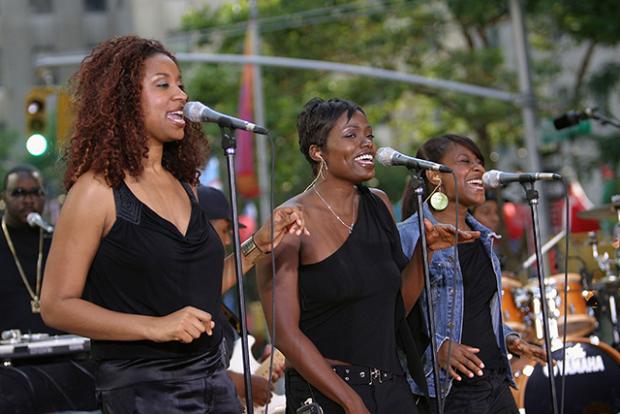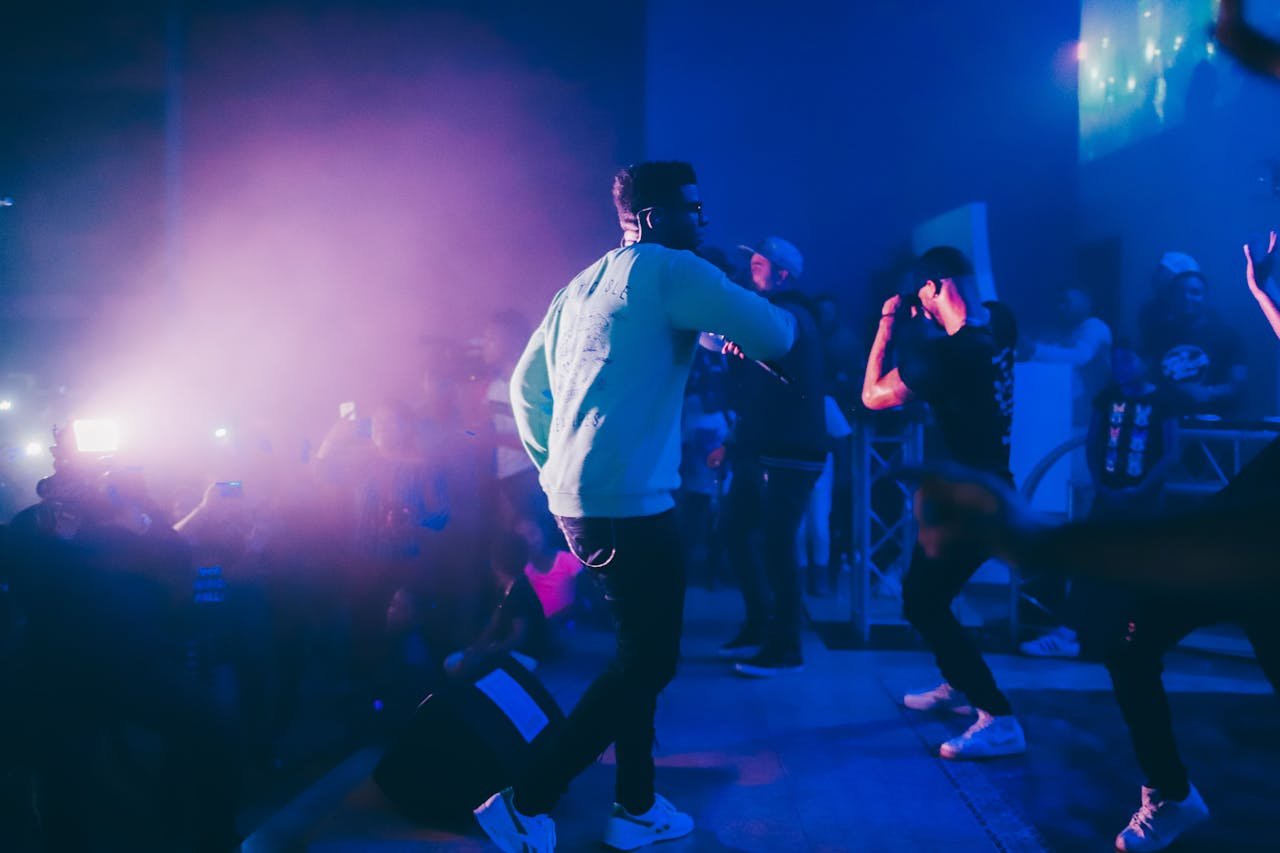Getty Images
You can hear backup singers, also called backing vocalists, background singers, or harmony vocalists, in almost every genre of music. While they’re singing, they may simultaneously be playing an instrument, dancing, or harmonizing with the lead singer. Whether they’re live in concert or recording in the studio, these singers play an important—but often overlooked—role in creating the band’s sound. We talked to a few about what it’s like to sing one step removed from the stars.
1. GOOD BACKUP SINGERS HAVE SKILLS THAT LEAD SINGERS MAY NOT HAVE.

Because backup singers must achieve a delicate balance of complementing the lead singer but not overshadowing them, they may have skills that lead singers don’t. Alex Trugman, a semi-finalist on Season 8 of American Idol, tells mental_floss that the number-one skill that backup singers need to have is precise pitch. “The lead singer might be able to get away with a flub here or there, but singing background, a flub will destroy whatever harmonic foundation you’re creating.”
Trugman adds that backup singers also need to be very good at sight-reading music. “I’ve known a lot of lead singers who can’t sight read, but it’s absolutely necessary [for backup singers] in a recording session.”
2. WORKING AS A BACKUP SINGER CAN IMPROVE YOUR MUSICIANSHIP …
Brittney Westover started as a solo artist and lead singer, but her experience singing backup for bands such as Saint Motel and SpongeBob & the Hi-Seas (featuring Tom Kenny, the voice of SpongeBob SquarePants) has been beneficial. Westover tells mental_floss that when she joined the ‘60s-style girl group The Damselles & The TC4, she was “surprised to learn that taking the supporting role as a backup singer can be just as enjoyable and satisfying as being a lead singer.”
Westover says the experience has improved her musicianship “tremendously”: “I can now sing and create harmony parts instantaneously to almost any song, which has helped my arranging skills, as well. This has come in handy for my own original songs.”
3. … AND BE A FREEING EXPERIENCE.
Similarly, Westover credits her role in The Damselles—trading off singing lead and backup vocals while performing synchronized choreography—as leading to an unexpected result. “I found myself creating this onstage persona, kind of an alter ego, that has so much more confidence and sex appeal than I do in real life. It was very liberating.”Being in the background rather than in the spotlight can be freeing for some backup singers. In a job singing backup on the Hannah Montana and Miley Cyrus: Best of Both Worlds Tour, Kay Hanley, the frontwoman of alternative rock band Letters to Cleo, says she learned choreography, performed in huge arenas for the first time, and wore sparkly outfits on stage. “I’ve never done that in my life. It was the funnest thing,” Hanley recalls in a 2013 interview.
4. BACKUP SINGERS EARN MUCH LESS INCOME, AND RECOGNITION, THAN LEAD SINGERS.
But it’s not all positive: Backup singers can bring in significantly less income and recognition than lead singers. In the 1960s in particular, many producers didn’t credit backup session singers as performers and often paid them meager amounts. For example, Darlene Love has been called perhaps the greatest backup singer of all time for her vocals on songs by artists such as Elvis Presley, Luther Vandross, and The Mamas & the Papas. In the early 1980s, however, she had to work as a cleaning lady in Beverly Hills to pay her bills. Ironically, while scrubbing a bathroom, she heard her own vocals on “Christmas (Baby Please Come Home)” playing on the radio.
5. EVEN SUCCESSFUL BACKUP SINGERS GET CRITICIZED FOR NOT AIMING HIGH ENOUGH.

In the 2013 documentary 20 Feet From Stardom, backup singers for famous artists shared a behind-the-scenes look at their lives. One of these singers, Lisa Fischer (pictured above), expresses her belief that backup singing—not lead singing—is her calling. Fischer sang backup for artists such as The Rolling Stones, Dolly Parton, and Beyoncé, but she won a Grammy for her first single “How Can I Ease The Pain” in 1992.
Despite achieving solo success, Fischer says that some people criticized her decision to not release another solo album. “I reject the notion that the job you excel at is somehow not enough to aspire to, that there has to be something more … I love supporting other artists.”
6. SOME TRY TO TURN THEIR BACKUP EXPERIENCE INTO A JOB AS A LEAD VOCALIST.

Of course, although some backup singers are content to make a career out of providing auxiliary vocals, others leverage the experience, training, and music industry contacts that they make working as a backup singer to become a lead vocalist. For example, successful solo artists such as Sheryl Crow, Whitney Houston, and Cher got their start as backup singers. Crow sang backup for Michael Jackson and Stevie Wonder, Houston sang backup for Chaka Khan, and Cher recorded background vocals on “Be My Baby” by The Ronettes and “You’ve Lost That Lovin’ Feelin’” by The Righteous Brothers.
7. IMAGE CAN BE JUST AS IMPORTANT FOR BACKUP SINGERS AS FOR LEAD SINGERS.
Backup singers, particularly female ones, can be subjected to the same body image expectations as lead singers. The Reddit user jesuswantsme shares her experience with sexism as a backup singer for a popular Christian Contemporary artist. She says, “When I was hired, everyone got wasted and the casting director told me the reason I made it to final callbacks was because I had the ‘good girl look’ and was ‘Christian sexy.’”
Although the appearance and attractiveness of backup singers is less noticeable than that of the lead singer, backup singers do contribute to the band’s overall image on stage. On her tour with Miley Cyrus, Hanley’s costume required that she wear long sleeves to hide her arm tattoos in order to fit in with Disney’s clean-cut image requirements for performers.
8. THE LEAD VOCALIST AND BACKUP SINGER CAN BE ONE AND THE SAME.

Not every famous solo artist uses backup singers to complement their voice. Some lead singers opt instead to simply record their own backup vocals. Robert Smith of The Cure, for example, sings his background vocals himself by overdubbing, recording more and more vocal tracks to create a bigger sound. When performing in concert, some artists sing along to a recorded track of their own backing vocals rather than employ backup singers.
9. IT’S NOT UNUSUAL FOR BACKUP SINGERS TO GET VERY COZY WITH LEAD SINGERS.
Because backup singers work closely and travel on tour with lead singers, they can become close friends or romantic partners with lead singers. Ray Charles notoriously had sex with his backup singers, for example, and musician Todd Rundgren married Michele Gray, who had toured with him as his backup singer. In addition, vocalist Carol Dennis, who toured as a backup singer for Bob Dylan, Stevie Wonder, and Bruce Springsteen, had a daughter with Dylan. Until 2001, their 1986 marriage, the birth of their daughter, and 1992 divorce were kept a secret. According to Dennis, “Bob and I made a choice to keep our marriage a private matter for a simple reason—to give our daughter a normal childhood.”








